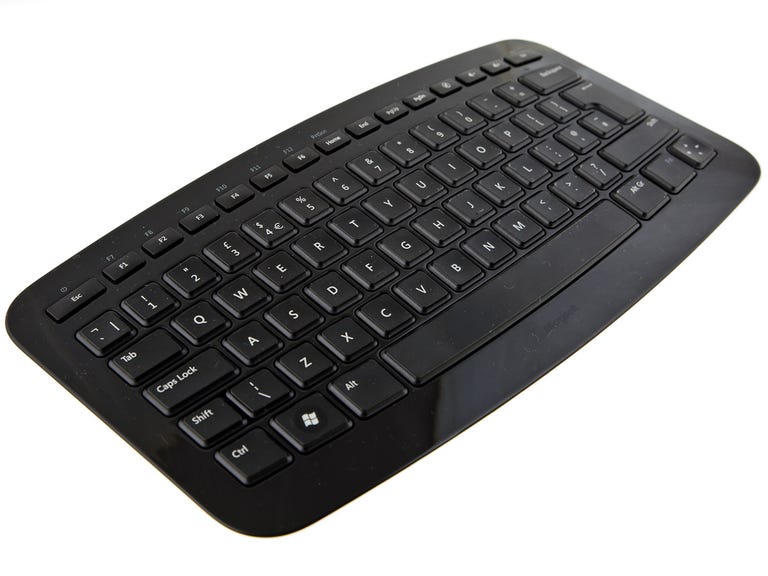 Why You Can Trust CNET
Why You Can Trust CNET Microsoft Arc Keyboard review: Microsoft Arc Keyboard
The compact, wireless Arc Keyboard delivers a comfortable and portable typing experience in a stylish package. It's fairly pricey but, if you want to navigate your media PC from the comfort of your couch, for example, it's well worth contemplating
The compact, wireless Microsoft Arc Keyboard is aimed squarely at home users. With its sleek curves and understated aesthetic, it's built to blend in. This keyboard also aims to deliver a comfortable and portable typing experience, and will set you back around £40.
The Good
The Bad
The Bottom Line
Transceiver fever
The Arc communicates with your computer via a 2.4GHz wireless transceiver that plugs into a USB socket. The transceiver itself is powered by two AAA batteries, housed in the Arc's underside. It snaps magnetically into a slot next to the battery housing for storage and transport purposes.
Plugging the transceiver into your computer will install the necessary drivers on your machine. No awkward software is required, and there's no driver disc to clutter up your desk's drawers. Installation takes only a few seconds, and then the Arc is ready to go. We were impressed with the speedy set-up, which takes the hassle out of using the Arc on multiple machines. If you prefer to tinker with the keyboard's functionality, the IntelliType Pro software, available from Microsoft's Web site, will let you reassign certain keys, and alter features such as the speed at which a character is repeated when you hold down a key.
Curves in all the right places
The Arc's distinctive, curved shape is designed to make typing comfortable on a small keypad. The design means you're unlikely to find your fingers competing for space, and, mercifully, no keys have been shifted into bizarre positions in an attempt to build a more ergonomic keyboard.

The keys themselves are extremely comfortable, with a pleasant spring to them that means you can type speedily and accurately. There's very little rattle, so you're unlikely to drive co-workers or family members wild with noisy, clattering keys. We particularly appreciate the extra-wide spacebar -- normally the first thing to go on compact typing devices.
One compromise Microsoft has made is condensing the arrow keys into a single multi-directional button, tucked under the right shift key. It's responsive enough, but, once they've been taken away, you'll quickly realise how often you used to use those four faithful buttons in everyday tasks, such as editing text or navigating DVD menus.
Along the top of the keyboard, you'll find volume-control keys, as well as the 'home', 'end', 'page up' and 'page down' keys, which have been shifted up to conserve keypad real estate. We'd have preferred a few more media keys (perhaps play/pause and skip-track buttons), seeing as one popular application for the Arc will undoubtedly be controlling home media.
The Arc is impressively lightweight and very slim -- you won't have any trouble moving it from room to room, or chucking it in your bag when you travel. Despite being light, the Arc feels sturdy, and rubber pads on its underside do a good job of anchoring it on a surface and preventing it from slipping out of your reach.
Limited appeal?
At around £40, the Arc isn't really the kind of item you're likely to buy on an impulse, and, although it's a great piece of kit in itself, we can only think of a few situations in which it would prove particularly useful.
We can see the Arc proving very useful for anyone who has a computer in their home that's dedicated to media playback. Plugged into a computer that's hooked up to your TV, the Arc would be perfect for sofa-based menu navigation.
Also, with the impending release of the Apple iPad, we'll undoubtedly see an avalanche of rival tablet computers, and, if touchscreen typing isn't your thing, the Arc would, again, prove very handy. Note, however, that you'll have to buy an adaptor to use the Arc with the iPad, as it lacks a USB port. The Arc will also work with Microsoft's Xbox 360 games console.
Conclusion
The Microsoft Arc Keyboard's relatively hefty price tag means it will only really appeal to a fairly niche audience. But, if you can think of a way in which a comfortable, portable keyboard would improve your life, and, if you can afford it, then we would absolutely recommend the Arc. We wouldn't recommend it as a replacement for a standard desktop keyboard, however, as the missing arrow keys will quickly become an irksome issue.
If the Arc Keyboard appeals, also check out the similarly priced, curved and comfortable Logitech Wireless Keyboard K350 before you make a decision.
Edited by Charles Kloet


